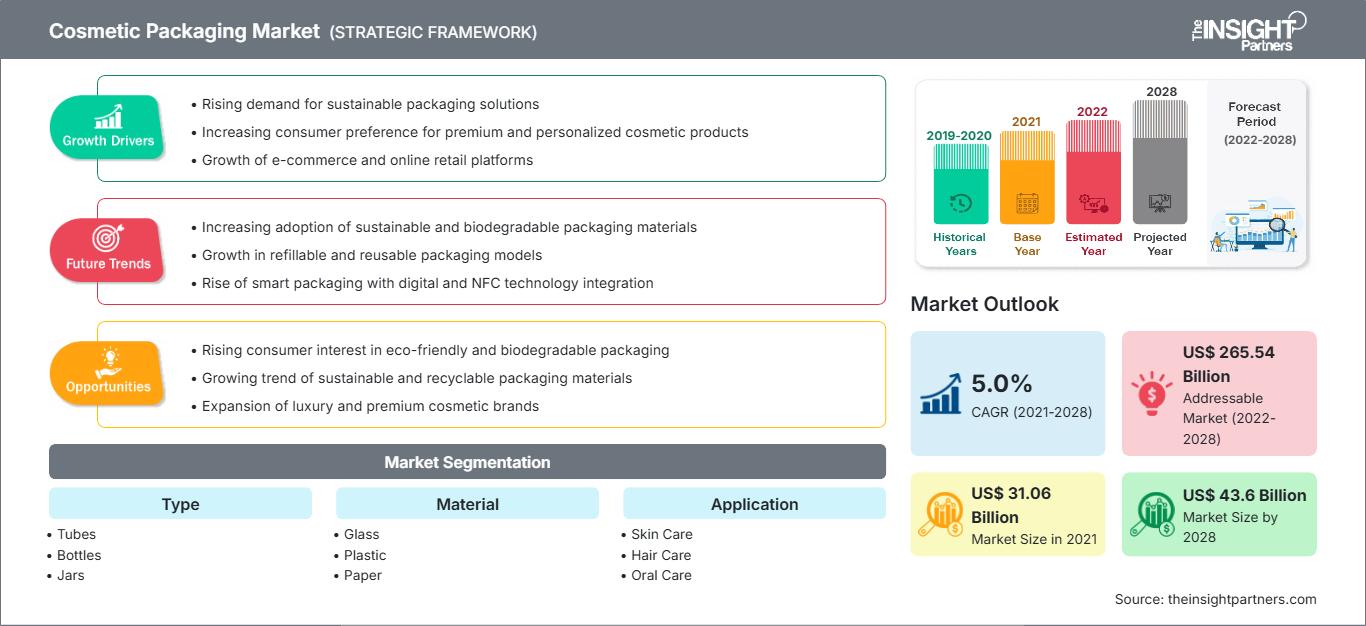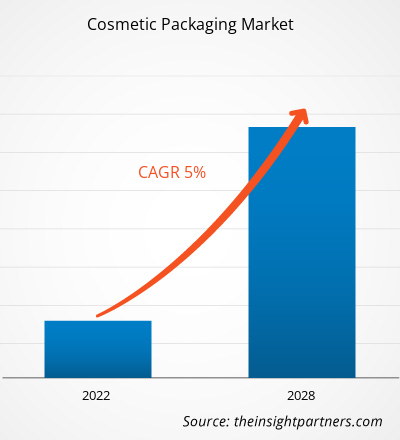2021 年化妆品包装市场价值为 310.647 亿美元,预计到 2028 年将达到 435.979 亿美元;预计 2021 年至 2028 年的复合年增长率为 5.0%。
市场的增长归因于快速发展的化妆品行业;女性化妆趋势的兴起;以及全球化妆工作室、美容诊所和沙龙数量的增加。此外,制造商专注于创造更好的包装设计,并通过创新包装巧妙地打造产品品牌,以吸引消费者。此外,通过在线零售渠道增长的化妆品销售额将在预测期内支撑市场增长。2020 年,亚太地区在全球化妆品包装市场中占有最大份额,预计在预测期内将在市场上实现最高的复合年增长率。亚太市场分为中国、印度、日本、韩国和澳大利亚。韩国、中国和日本等国家因其独特的化妆和护肤习惯日益普及,已成为化妆品和个人护理产品的主要市场。由于快速的城市化、显著的经济发展、文化多样性以及新兴彩妆潮流的日益普及,亚太地区化妆品包装市场正经历着显著的增长。
自定义此报告以满足您的要求
您将免费获得任何报告的定制,包括本报告的部分内容,或国家级分析、Excel 数据包,以及为初创企业和大学提供超值优惠和折扣
化妆品包装市场: 战略洞察

- 获取本报告的主要市场趋势。这个免费样本将包括数据分析,从市场趋势到估计和预测。
新冠疫情对化妆品包装市场的影响
由于不同地区的长期封锁、制造单位停工、旅行、国际贸易和供应链受限以及原材料供应短缺,新冠疫情严重影响了制造业的运营效率。新冠疫情对全球化妆品包装市场造成了负面影响,原因包括制造单位停工、原材料价格上涨、劳动力短缺、供应链中断以及金融不稳定。此外,新冠疫情导致的经济放缓,对化妆品行业造成了冲击,阻碍了化妆品包装市场的增长。然而,随着各国逐步放松先前实施的限制措施,企业正在蓬勃发展。此外,各国政府推出的新冠疫苗进一步缓解了疫情,导致全球商业活动活跃起来。此外,各国政府正在计划建设现代化、技术先进的基础设施,以减轻疫情对经济的影响。在封锁期间,消费者在家中进行皮肤护理和疗法,这极大地推动了对化妆品的需求。因此,尽管受到 COVID-19 疫情的影响,但预计未来几年化妆品包装市场仍将实现显著增长。您将免费获得任何报告的定制,包括本报告的部分内容,或国家级分析、Excel 数据包,以及为初创企业和大学提供超值优惠和折扣
化妆品包装市场: 战略洞察

- 获取本报告的主要市场趋势。这个免费样本将包括数据分析,从市场趋势到估计和预测。
市场洞察:化妆品行业
近年来,人们的外貌意识不断增强,导致对化妆品的需求增加。北美和欧洲被认为是全球最大的化妆品市场。根据欧莱雅的数据,2019 年全球化妆品行业的增长率为 5.5%。据 Cosmetics Europe 称,欧洲化妆品市场规模从 2018 年的 89.30 美元增长到 2019 年的 90.66 美元。此外,由于男性和女性的美容趋势发生变化,对化妆品的需求增加预计将推动化妆品行业的发展。近年来,化妆品行业已从以女性产品为主转向服务于所有性别的行业,这扩大了该行业的消费者群体。化妆品行业不断扩大的消费者群体导致对化妆品包装产品的需求旺盛,进一步推动了市场增长。
应用洞察
根据应用,全球化妆品包装市场细分为皮肤护理、头发护理、口腔护理等。2020 年,皮肤护理领域占据了最大的收入份额。越来越多的美妆达人推出各种化妆和护肤教程,这些教程越来越受到人们的欢迎。此外,使用防晒霜、皮肤修复晚霜和香水等产品的趋势日益增长,推动了对护肤产品的需求。化妆品包装用于各种护肤产品,例如保湿霜、护手霜、洁面乳和去角质霜。护肤品包装旨在保护产品免受空气、光、热、冷、湿气、灰尘和污垢的侵害,并防止其被篡改。例如,聚丙烯包装因其柔韧性而被广泛应用于各种护肤品,使其成为可挤压软管的理想选择。此外,护肤品牌也开始认识到护肤品包装的环境效益。ALBEA、APC PACKAGING、AptarGroup, Inc.、Berry Global Inc.、Gerresheimer AG、WWP Beauty、Silgan Plastics.、Huhtamaki、LIBO Cosmetics 和 HCP Packaging 等公司都是化妆品包装市场的参与者。这些公司为市场提供广泛的产品组合。这些公司在发展中地区都有业务,这为化妆品包装市场的增长提供了丰厚的利润机会。市场参与者正在开发高质量和创新的产品,以满足客户的要求。
报告重点
- 化妆品包装市场的渐进式行业趋势,帮助参与者制定有效的长期战略
- 发达市场和发展中市场采用的业务增长战略
- 2019 年至 2028 年化妆品包装市场的定量分析
- 全球化妆品包装需求估计
- 波特五力分析,说明行业买家和供应商的效力
- 了解竞争激烈的市场形势的最新发展
- 市场趋势和前景以及推动和抑制化妆品包装市场增长的因素
- 通过强调支撑商业利益的市场策略来协助决策过程,从而促进市场增长
- 化妆品包装市场在各个节点的规模
- 市场以及化妆品包装行业的详细概述和细分动态
- 各地区化妆品包装市场规模及增长潜力
化妆品包装市场
The Insight Partners 的分析师已详尽阐述了预测期内影响化妆品包装市场的区域趋势和因素。本节还探讨了北美、欧洲、亚太地区、中东和非洲以及南美和中美洲的化妆品包装市场细分和地域分布。
化妆品包装市场报告范围
| 报告属性 | 细节 |
|---|---|
| 市场规模 2021 | US$ 31.06 Billion |
| 市场规模 2028 | US$ 43.6 Billion |
| 全球复合年增长率 (2021 - 2028) | 5.0% |
| 历史数据 | 2019-2020 |
| 预测期 | 2022-2028 |
| 涵盖的领域 |
By 类型
|
| 覆盖地区和国家 | 北美
|
| 市场领导者和主要公司简介 |
|
化妆品包装市场参与者密度:了解其对业务动态的影响
化妆品包装市场正在快速增长,这得益于终端用户需求的不断增长,而这些需求又源于消费者偏好的不断变化、技术进步以及对产品优势的认知度不断提升等因素。随着需求的增长,企业正在不断扩展产品线,不断创新以满足消费者需求,并抓住新兴趋势,从而进一步推动市场增长。

- 获取 化妆品包装市场 主要参与者概述
《2028年全球化妆品包装市场分析》是一项针对化学品和材料行业的专业深入研究,特别关注全球化妆品包装市场趋势分析。该报告旨在提供市场概览和详细的市场细分。化妆品包装市场根据产品类型、材料、应用和地域进行细分。按类型,化妆品包装市场分为管装、瓶装、罐装、泵装和分配器装等。按材料,市场分为玻璃、塑料、纸张、金属装等。按应用,化妆品包装市场分为皮肤护理、头发护理、口腔护理等。按地域,市场大致分为北美、欧洲、亚太地区 (APAC)、中东和……非洲 (MEA) 以及南美洲和中美洲。
公司简介
- ALBEA
- APC PACKAGING
- AptarGroup, Inc.
- Berry Global Inc.
- Gerresheimer AG
- WWP Beauty
- Silgan Plastics.
- Huhtamaki
- LIBO Cosmetics
- HCP Packaging
- 历史分析(2 年)、基准年、预测(7 年)及复合年增长率
- PEST和SWOT分析
- 市场规模、价值/数量 - 全球、区域、国家
- 行业和竞争格局
- Excel 数据集
近期报告
相关报告
客户评价
购买理由
- 明智的决策
- 了解市场动态
- 竞争分析
- 客户洞察
- 市场预测
- 风险规避
- 战略规划
- 投资论证
- 识别新兴市场
- 优化营销策略
- 提升运营效率
- 顺应监管趋势




















 获取免费样品 - 化妆品包装市场
获取免费样品 - 化妆品包装市场